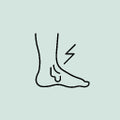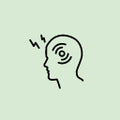Hypothalamus involved in migraine
The hypothalamus located in the central nervous system plays an essential role in the release of endocrine hormones. It is a sensor of body stimuli and participates in many functions, such as the sleep cycle, hunger, thirst, etc. It has been demonstrated in migraine patients a permanent hyperexcitability (even between attacks) of the hypothalamus. This could explain its early hyperactivation and the warning symptoms that the patient feels before the onset of the migraine attack during the prodromes, such as the feeling of thirst, hunger, yawning or intense fatigue.
We recommend reading: The mechanism of migraine to fully understand this article
The hypothalamus involved in nociception:
Somatosensory and visceral nociceptive information from the head and orofacial structures travels through direct and indirect pathways that carry this information to the hypothalamus and thalamus 1–4 .
The hypothalamus has many anatomical connections with pain modulation areas and the trigeminal nucleus 5–7 .
One study demonstrated by MRI an activation of the hypothalamus during migraine attacks, as well as an increase in blood flow that persisted after the attack and after the administration of sumatriptan 8 .
Involved in autonomous functions:
Orexinergic neurons are present in large numbers in the hypothalamus; they are involved in arousal, appetite, and some autonomic functions 9 . This orexinergic system is increasingly studied in the pathophysiology of migraine. Pharmacological blockade of orexin receptors inhibits cortical invasive depression in rats and also attenuates meningeal arterial vasodilation caused by nociceptive activation of the trigeminal system 10 .
The dopaminergic system also appears to be involved. Indeed, the premonitory symptoms found during migraine attacks such as fatigue, yawning, changes in appetite and nausea involve the activation of the dopaminergic system 11 .
Dopamine or agonist application within the trigeminal sensory complex (TSC) inhibits their activation after nociceptive stimulation. The dopaminergic nucleus A11 of the hypothalamus could be the probable source of this dopamine 12 .
The salivary nucleus is partly under the control of the hypothalamus via descending pathways from the lateral and paraventricular nuclei , as well as the parabrachial nucleus. These regions are primarily involved in the regulation of sleep, hunger, stress, and may contribute to the vegetative symptoms associated with migraine attacks.
Find our range of products designed to treat migraines and headaches.
References
(1) Burstein, R.; Dado, RJ; Giesler, GJ The Cells of Origin of the Spinothalamic Tract of the Rat: A Quantitative Reexamination. Brain Res. 1990 , 511
(2), 329–337. https://doi.org/10.1016/0006-8993(90)90179-f. (2) Burstein, R.; Cliffer, D.; Giesler, J. Direct Somatosensory Projections from the Spinal Cord to the Hypothalamus and Telencephalon. 1987 , 6.
(3) Malick, A.; Strassman, RM; Burstein, R. Trigeminohypothalamic and Reticulohypothalamic Tract Neurons in the Upper Cervical Spinal Cord and Caudal Medulla of the Rat. J. Neurophysiol. 2000 , 84 (4), 2078–2112. https://doi.org/10.1152/jn.2000.84.4.2078.
(4) Veinante, P.; Jacquin, MF; Deschênes, M. Thalamic Projections from the Whisker-Sensitive Regions of the Spinal Trigeminal Complex in the Rat. J.Comp. Neurol. 2000 , 420 (2), 233–243. https://doi.org/10.1002/(sici)1096-9861(20000501)420:2<233::aid-cne6>3.0.co;2-t.
(5) Bartsch, T.; Levy, MJ; Knight, Y.E.; Goadsby, PJ Inhibition of Nociceptive Dural Input in the Trigeminal Nucleus Caudalis by Somatostatin Receptor Blockade in the Posterior Hypothalamus. Bread 2005 , 117 (1–2), 30–39. https://doi.org/10.1016/j.pain.2005.05.015.
(6) May, A.; Burstein, R. Hypothalamic Regulation of Headache and Migraine. Cephalalgia 2019 , 39 (13), 1710–1719. https://doi.org/10.1177/0333102419867280.
(7) Abdallah, K.; Artola, A.; Monconduit, L.; Dallel, R.; Luccarini, P. Bilateral Descending Hypothalamic Projections to the Spinal Trigeminal Nucleus Caudalis in Rats. PLoS ONE 2013 , 8
(8). https://doi.org/10.1371/journal.pone.0073022. (8) Denuelle, M.; Fabre, N.; Payoux, P.; Chollet, F.; Geraud, G. Hypothalamic Activation in Spontaneous Migraine Attacks. Headache J. Head Face Pain 2007 , 0 (0), 070503104159006-??? https://doi.org/10.1111/j.1526-4610.2007.00776.x.
(9) Holland, P.; Goadsby, PJ The Hypothalamic Orexinergic System: Pain and Primary Headaches. Headache 2007 , 47 (6), 951–962. https://doi.org/10.1111/j.1526-4610.2007.00842.x.
(10) Hoffmann, J.; Supronsinchai, W.; Akerman, S.; Andreou, AP; Winrow, C.J.; Renger, J.; Hargreaves, R.; Goadsby, PJ Evidence for Orexinergic Mechanisms in Migraine. Neurobiol. Say. 2015 , 74 , 137–143. https://doi.org/10.1016/j.nbd.2014.10.022.
(11) Akerman, S.; Goadsby, P. Dopamine and Migraine: Biology and Clinical Implications. Cephalalgia 2007 , 27 (11), 1308–1314. https://doi.org/10.1111/j.1468-2982.2007.01478.x.
(12) Charbit, AR; Akerman, S.; Goadsby, PJ Dopamine: Whatʼs New in Migraine?: Curr. Opinion. Neurol. 2010 , 23 (3), 275–281. https://doi.org/10.1097/WCO.0b013e3283378d5c.







